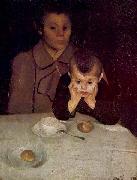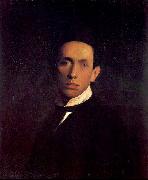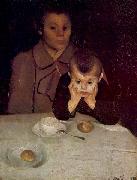Josip Racic Olja Måleriet ReproduceringAll Josip Racic Oil Paintings(1885 - 1908) was a Croatian painter in the early 20th century. Although he died very young (he was only 23), and his work was mostly created when a student, he is one of the best known of the modern Croatian painters. Today, Račić is regarded as one of the most important representatives of Croatian modern painting. He studied lithography in Zagreb, and 1904 he went to Vienna and Munich, where he studied for a year at the school of the Slovene painter and teacher Anton Ažbe, followed by 3 years at the prestigious Academy of Arts. There, Racic, along with Oskar Herman, Vladimir Becić and Miroslav Kraljević formed the group known as the Croatian School. In 1908, he went to Paris where he painted a series of watercolors and oils depicting Parisian bridges, avenues and parks. He died of a gunshot wound in a Paris hotel room in June 1908, having committed suicide. Josip Račić is one of the founders of modern Croatian art, the first to bring the concept of self-awareness and artistic integrity to his life and works, "pure painting", as he called it. A particular feature of his paintings is the strong dark realms of human spirituality. A retrospective of his work was held in the Modern Gallery in Zagreb and Dubrovnik in 2008-2009, to mark the 100th anniversary of the artist's death. |
|||

|
|||
|
|
|||
|
||||||||
| Josip Racic (1885 - 1908) was a Croatian painter in the early 20th century. Although he died very young (he was only 23), and his work was mostly created when a student, he is one of the best known of the modern Croatian painters. Today, Račić is regarded as one of the most important representatives of Croatian modern painting. He studied lithography in Zagreb, and 1904 he went to Vienna and Munich, where he studied for a year at the school of the Slovene painter and teacher Anton Ažbe, followed by 3 years at the prestigious Academy of Arts. There, Racic, along with Oskar Herman, Vladimir Becić and Miroslav Kraljević formed the group known as the Croatian School. In 1908, he went to Paris where he painted a series of watercolors and oils depicting Parisian bridges, avenues and parks. He died of a gunshot wound in a Paris hotel room in June 1908, having committed suicide. Josip Račić is one of the founders of modern Croatian art, the first to bring the concept of self-awareness and artistic integrity to his life and works, "pure painting", as he called it. A particular feature of his paintings is the strong dark realms of human spirituality. A retrospective of his work was held in the Modern Gallery in Zagreb and Dubrovnik in 2008-2009, to mark the 100th anniversary of the artist's death. |
||||||||
|
|
||||||||
| Måleriet Identifieringen :: 81474 Mother and a child Mother and a childx, oil on canvas (90,2x68,4 cm) from 1908 by Croatian painter Josip Račić (died in 1908.) cjr |
||||||||
|
|
||||||||
| Måleriet Identifieringen :: 84318 Self-portrait. 1908 Medium Oil on canvas. Dimensions 65.1 x 53.1 cm (25.6 x 20.9 in). cyf |
||||||||
|
|
||||||||
| Måleriet Identifieringen :: 85480 Mother and a child oil on canvas (90,2x68,4 cm cyf |
||||||||
|
|
||||||||
|
| FÖREGÅENDE KONSTNÄR Nästa Konstnär | |||||||
|
|
||||||||
|
Josip Racic (1885 - 1908) was a Croatian painter in the early 20th century. Although he died very young (he was only 23), and his work was mostly created when a student, he is one of the best known of the modern Croatian painters. Today, Račić is regarded as one of the most important representatives of Croatian modern painting. He studied lithography in Zagreb, and 1904 he went to Vienna and Munich, where he studied for a year at the school of the Slovene painter and teacher Anton Ažbe, followed by 3 years at the prestigious Academy of Arts. There, Racic, along with Oskar Herman, Vladimir Becić and Miroslav Kraljević formed the group known as the Croatian School. In 1908, he went to Paris where he painted a series of watercolors and oils depicting Parisian bridges, avenues and parks. He died of a gunshot wound in a Paris hotel room in June 1908, having committed suicide. Josip Račić is one of the founders of modern Croatian art, the first to bring the concept of self-awareness and artistic integrity to his life and works, "pure painting", as he called it. A particular feature of his paintings is the strong dark realms of human spirituality. A retrospective of his work was held in the Modern Gallery in Zagreb and Dubrovnik in 2008-2009, to mark the 100th anniversary of the artist's death. |
||||||||
|
|
||||||||
|
KOMMA I KONTAKT MED Oss |








